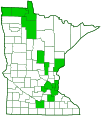Potter’s grass spider
(Agelenopsis potteri)
Conservation • Description • Habitat • Ecology • Distribution • Taxonomy
Conservation Status |
|||
| IUCN Red List | not listed |
||
| NatureServe | NNR - Unranked |
||
| Minnesota | not listed |
||
Description |
Potter’s grass spider is a medium-sized, sedentary spider. It is native to and occurs across North America from Nova Scotia to Virginia west to southern British Columbia and Colorado. It has also been introduced to the Ukraine and Kyrgyzstan. It is found in areas with grass, shrubs, rocks, or buildings. It builds its web on lawns, in taller grasses, on low shrubs, on stone fences, in corners of buildings, and in basements. The female is ⅜″ to 9⁄16″ (9 to 14 mm) in length not including the legs. The male is a little smaller, 5⁄16″ to ½″ (8 to 13 mm) in length. The hardened plate (carapace) covering the front part of the body (cephalothorax) is longer than wide. The rear portion (thoracic region) is large, about as long as wide, and broadly rounded. The front portion (head region) is small, straight-sided, and narrow, about half as wide as the thoracic region. The carapace is yellowish to light brown. A pair of broad dark bands extends from the eye region to the rear margin. There is also a thin dark line on the lateral margins. The face is vertical. The finger-like sensory mouthparts (palps) on the male are relatively very large. The jaw-like mouthparts (chelicerae) are reddish-brown, stout, and vertical. There is a fang at the end of each chelicera. The fang rests in a groove. The fang groove has three teeth on the front margin and three teeth on the hind margin. On the male, the leaf-like extension (embolus) at the tip of the genital bulb is hooked. There are eight eyes arranged in two rows of four eyes each. Both rows are strongly curved and close together, so that the anterior median eyes (AME) and the posterior lateral eyes (PLE) form almost a straight line. The eyes are slightly unequal in size. The AME are the largest and the posterior median eyes (PME) are the smallest. The abdomen is yellowish-gray to reddish-brown above, with a broad pale median stripe and a broad pale stripe on each side. The central plate on the underside (sternum) is yellow to brown and has a distinct, very dark, V-shaped mark. Like other funnel-web spiders, the spinnerets extend well beyond the end of the abdomen and are visible from above. The abdomen is usually large, broad, and thickest in the middle on the female, smaller, narrow, and thickest closer to the base on the male. It is pointed at the rear on both sexes. The legs are long, thin, and spiny. Like other grass spiders, they have dark and light bands, but on this species the bands are less distinct. The second segment (trochanter) is not notched. The last segment (tarsus) has three claws at the tip, but these may not be visible without magnification. There is no tuft of hairs (scopula pads) at the end of the tarsus. |
Size |
Female Body Length: ⅜″ to 9⁄16″ (9 to 14 mm) Male Body Length: 5⁄16″ to ½″ (8 to 13 mm) |
Web |
The web is a flat sheet with a funnel on one side and a barrier above. The threads are not sticky. The sheet is horizontal or nearly horizontal and slightly concave. The funnel is small and serves as a retreat. It is open at the lower end allowing the spider to escape if disturbed. The barrier is three-dimensional. When a flying insect hits the barrier it drops to the sheet and its feet become entangled in the threads. The spider, which had been waiting in the retreat, rushes out, bites the insect to subdue it, and drags it back to the retreat to consume it. Webs are built on lawns, in taller grasses, on low shrubs, on stone fences, in corners of buildings, and in basements. The web starts small and thin but is expanded as the season progresses. Each time the spider passes over the web it leaves a drag line, making the sheet thicker. Webs built in grass are most noticeable in the morning when they collect dew. Webs built in protected areas of buildings may last for years. |
Similar Species |
Habitat |
Grassy areas, lawns, low shrubs, stone fences, and buildings. |
Ecology |
Season |
|
Behavior |
When the spider feels a vibration on the web it rushes out to the source and, if it is prey, bites it. It is very fast, sometimes described as “lightning-quick”. |
Life Cycle |
In the late summer or fall the female lays eggs, encloses in a silken sac, and conceals it near the web. The sac overwinters and the eggs hatch in the spring. Adults do not survive the winter. |
Food |
|
Distribution |
||
|
Sources |
|
| 9/10/2025 | ||
Occurrence |
||
|
||
Taxonomy |
|
Class |
Arachnida (arachnids) |
Order |
|
Suborder |
Araneomorphae (typical spiders) |
Infraorder |
Entelegynae |
Zoosection |
RTA clade spiders |
Zoosubsection |
Marronoid (meshweavers and allies) |
Family |
|
Subfamily |
Ageleninae (typical funnel weavers) |
Genus |
|
Subordinate Taxa |
|
|
|
Synonyms |
|
Agelena potteri Agelenopsis albipilis |
|
Common Names |
|
common grass funnelweaver Potter’s grass spider |
|
Glossary
Carapace
The hard, upper (dorsal), shell-like covering (exoskeleton) of the body or at least the thorax of many arthropods and of turtles and tortoises. On crustaceans, it covers the cephalothorax. On spiders, the top of the cephalothorax made from a series of fused sclerites.
Cephalothorax
The front part of the body of various arthropods, composed of the head region and the thoracic area fused together. Eyes, legs, and antennae are attached to this part.
Chelicerae
The pair of stout mouthparts, corresponding to jaws, in arachnids and other arthropods in the subphylum Chelicerata.
Palp
Short for pedipalp. A segmented, finger-like process of an arthropod; one is attached to each maxilla and two are attached to the labium. They function as sense organs in spiders and insects, and as weapons in scorpions. Plural: palpi or palps.
Tarsus
On insects, the last two to five subdivisions of the leg, attached to the tibia; the foot. On spiders, the last segment of the leg. Plural: tarsi.
Visitor Photos
Share your photo of this arachnid.
This button not working for you?
Simply email us at info@MinnesotaSeasons.com.
Attach one or more photos and, if you like, a caption.
Luciearl |
||
… spider living in tiny bird house near our front door. Also noted several wrapping webs around the nearby sumac leaves creating a den, somewhat of a cave. |
||
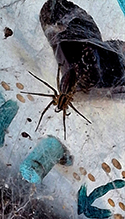 |
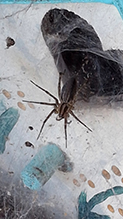 |
|
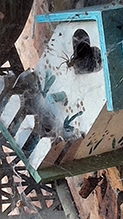 |
||
Andy Lamberson |
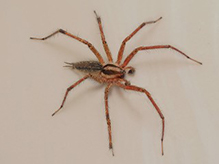 |
Found in the 1st floor bathroom sink. I took some images and then carefully captured it and released it outside. |
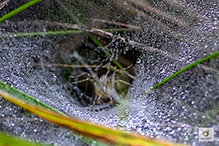 |
|
KC Paulson |
||
Webs |
||
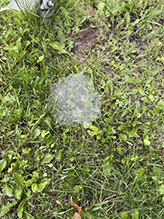 |
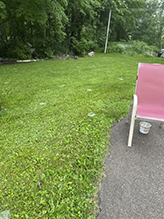 |
|
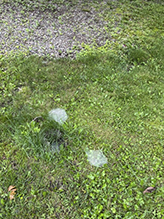 |
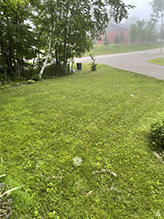 |
|
Alfredo Colon |
||
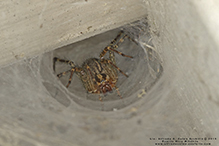 |
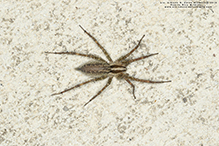 |
|
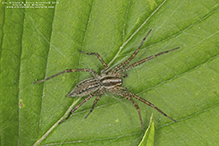 |
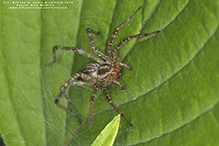 |
|
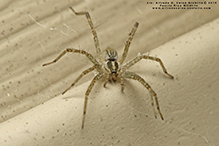 |
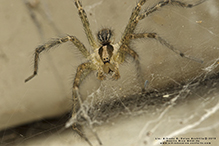 |
|
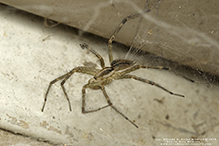 |
||
MinnesotaSeasons.com Photos
|
||

Slideshows

Visitor Videos
Share your video of this arachnid.
This button not working for you?
Simply email us at info@MinnesotaSeasons.com.
Attach a video, a YouTube link, or a cloud storage link.
Other Videos
Photographing a male grass spider
Adrian Thysse
Agelenopsis potteri
олег пожаров
TX Rabid Wolf Spider Attacks Man!! A video for halloween and beyond.
Healthy Family Variety Channel

Visitor Sightings
Report a sighting of this arachnid.
This button not working for you?
Simply email us at info@MinnesotaSeasons.com.
Be sure to include a location.
Luciearl
September 2025
Location: Lake Shore, MN
… spider living in tiny bird house near our front door. Also noted several wrapping webs around the nearby sumac leaves creating a den, somewhat of a cave.
Andy Lamberson
8/9/2025
Location: Winona, MN
Found in the 1st floor bathroom sink. I took some images and then carefully captured it and released it outside.
MinnesotaSeasons.com Sightings

